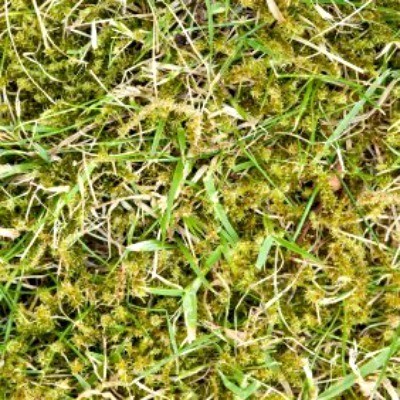The invasion of moss in your lawn occurs when you try to grow grass in places that are too shady, too wet, or on very poor soil-conditions that do not support grass. To eliminate moss and prepare the soil for grass, you'll need to change your lawn's growing conditions.
The best way to discourage moss is to grow better grass, and to do that you need to create the right conditions. If your lawn has moss, then you probably dealing with underlying soil problems such as compaction, low fertility, acidity, excess moisture, inadequate soil depth or excessive shade. Start with a simple soil test. Your county extension agency can give you more information on how to go about collecting samples and where to send them. Tests are inexpensive (usually around $15) and will give you a wealth of information about your soil, including pH and nutrients levels, as well as recommendations for fixing any problems.
The fact that the moss is growing in a specific area signals that it's not an ideal environment for growing grass. If you can change the following environmental conditions, you may be able to promote the growth of grass over moss. If you can't, planting a shade-tolerant ground cover may be a better solution.
If moss is still a problem after trying the above methods, here are some simple homemade recipes to help get rid of it. Although these solutions are considered more environmentally friendly (at least compared to commercial moss killers), they should still be applied with caution as they are capable of killing or injuring the surrounding grass.
Homemade Recipe #1
Mix together and saturate small areas using a hand sprayer.
Homemade Recipe #2
Mix together and saturate small areas using a hand sprayer.
Homemade Recipe #3
Use this recipe if you need to kill moss over a large area. Apply with a 20-gallon hose-end sprayer attachment, and repeat every two weeks until the moss dies.
Once the moss is dead (it will lose its color and start drying up), remove it using a heavy garden rake with fixed metal tines. Keep in mind that killing moss is only a temporary solution, so if you want to remove it permanently you will need to correct the soil conditions that allowed it to thrive. After removing the moss, retest your soil, add any necessary amendments, and re-seed the bare areas with a grass mixture suitable for the light conditions.
If you have tried everything and the moss will simply not retreat, then consider living with it. There's nothing wrong with letting (even encouraging) moss to grow. In fact, there are entire books and websites dedicated solely to the art of moss gardening! As a ground cover, moss has a lush green color, it's velvety on bare feet, and it's virtually maintenance-free. Instead of fighting Mother Nature, try defining the area with large rocks, pieces of driftwood, or interesting statuary. If done right, a moss garden can be a beautiful way to enhance your existing landscape.

About The Author: Ellen Brown is an environmental writer and photographer and the owner of Sustainable Media, an environmental media company that specializes in helping businesses and organizations promote eco-friendly products and services.
Add your voice! Click below to comment. ThriftyFun is powered by your wisdom!
I love moss! Anne in NC
Me too it s my favourite plant followed closely
by Sweet peas but this is for sentimental reasons as my daughter had her photo took on the lawn holding Sweet peas. She was 7months old and died 2 days later of Meningitis That was back in 1978, fortunately times have changed and parents are more aware.
Add your voice! Click below to comment. ThriftyFun is powered by your wisdom!